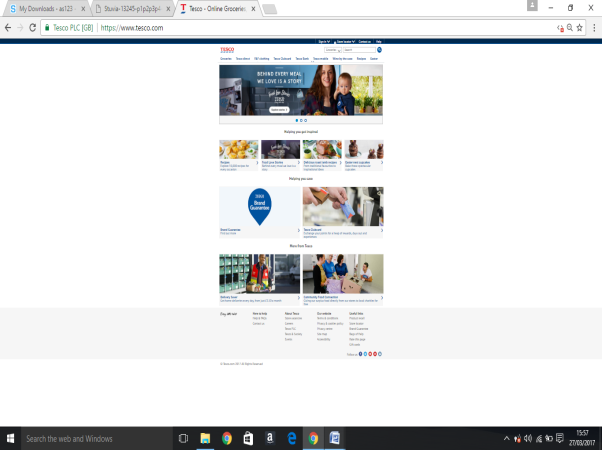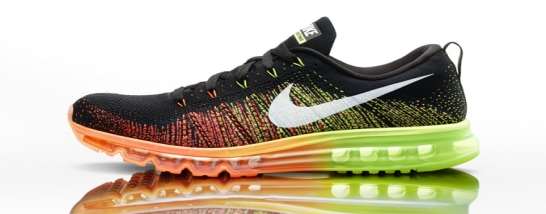Analysis of Tesco Website and Finances
| ✅ Paper Type: Free Essay | ✅ Subject: Business |
| ✅ Wordcount: 2165 words | ✅ Published: 13 Sep 2017 |
Introduction:
In this task I am looking at three different methods of appropriate to the user’s needs of Tesco. The three methods I be doing is a report of the Tesco’s business e.g. finance, chart of showing the financial report and a web page. I also be producing a corporation communications e.g. poster. Then I also am evaluating the external corporate communication of an existing product or service. In the last, I will be evaluating the effectiveness of business information and its communication as key contributors to the success of an organisation, using examples to illustrate your point which will cover P1,P2 and P3.
Report: Tesco Internal results 2014/2015: For the UK like-for-like sales it had decreased by 4.6%, which was impacted by the strong competition by its rivals across the grocery market, there was headwinds such as price cuts and fewer untargeted promotions. Tesco had an £0.9bn Group trading profit with a year-on-year decline which reflected the challenges of its UK business. Tesco had its Total UK online sales raised to 11%; with like-for-like sales growth of +0.8% in UK convenience stores. The Interim dividend was at 1.16p as previously announced; with full-year capital expenditure reduced to £2.1bn. The New Executive team in place was reviewing all strategic options to create a greater shareholder value.
Preliminary results 13/14: Tesco has had an £3.3bn trading profit & year-on-year decline which they must reflects the challenges of its operations in UK and Europe. For the final dividend it was maintained at 10.13p, which has given them a full-year dividend of 14.76p. Moreover the UK sales exc. petrol had risen by +0.8%, which had a lower net new space contribution than previously planned. There has been strong UK growth in the online grocery department by +11% and its Express LFL had risen by+1.1%. Moreover, in the UK LFL inc. VAT, exc. petrol was reduced by 1.3% as this was caused by the transformation of the general merchandise which means it was made weaker and has an highly increasing competitive grocery market in the second half. There has been near 300 UK stores which has been refreshed this year – with the typical sales uplift in the range 3% – +5%. Also there has been ongoing multichannel focus – with grocery home shopping launched in five countries around the globe.
There has been a consistent approach to capital discipline, returns and cash. Internal results 13/14: There was a £1.6bn trading profit – which means that there was good progress in the UK and its operations across Europe. Moreover, the interim dividend was maintained at 4.63p and the UK sales exc. petrol had risen by +1.7%, which had lower net new space contribution than previously planned. The Sales was supported by strong growth in the online grocery department which was +13% in the UK and also +54% overseas. Also, UK Food LFL had improved by +1.0% in Q2; the UK trading margin remained stable at 5.2%. Furthermore, the total UK LFL was decreased by the initial work for the transformation of the general merchandise business, with it being ahead of the intended migration to higher margin, with higher-growth categories. Additionally, average large-store refreshes there had been a sales uplift from the range 3%-5%, which had improved margin. For the Q2 UK Clothing it had a sales growth of +8.6%. The United States Strategic review concluded with the sale of the Fresh & Easy to Yucaipa there had been a Partnership formed with CRE which had given Tesco a 20% stake in China’s leading food retailer. There has been a consistent approach to its future growth, capital discipline, returns and cash.
For the preliminary results 12/13: there was an £3.5bn trading profit which its year by year performance largely reflected the reinvestment for the UK. Also its final dividend was maintained at 10.13p, which gave a full-year dividend of 14.76p. It had good progress in the UK, which delivered improved results – for its customers and for Tesco. The report showed a strong online performance: with the Group sales doing especially well as it made over £3bn for the first time which had risen by 13%. There was confirming exit from the United States which its process was well-advanced. For the F+F brand clothing its sales were now over £1bn in the UK alone, which had +9% LFL sales growth. This shows that the company has a clear approach on its future growth, the capital expenditure, also the returns and cash, providing highly intended clarity for its shareholders. The Internal results 12/13: it had Group sales which had risen by 1.4% to £36.0bn (which was up by 3.2% at constant rates); the Group sales exc. petrol has risen to 1.6% with an increased 3.7% at constant rates. Moreover for the statutory profit before tax has decreased at 11.6 % to £1.7bn; there has been an underlying profit before the tax which has been decreased to 8.5% to £1.8bn. Furthermore, for the group trading profit which made £1.6bn, this has decreased by 10.5% and in the UK has been decreased by 12.4% to £1.1bn; with its International operations also decreasing by 17.1% to £0.4bn; there has been an amazing report with the Tesco Bank as this was has done the most successful which has raised by 114% to £94m. Additionally, the report also says the underlying diluted eps reduction which was at 7.9% and the interim dividend per share was maintained at 4.63p. Also the group capital expenditure had been brought down from £2.1bn to £1.6bn which is a £500 million drop; which will mean that it is on track for a full year reduction to £3.2bn.
Preliminary results 11/12: For the Group sales it has risen 7.4% to £72.0bn, which was up 5.9% exc. petrol. Also the Statutory profit before tax had risen by 5.3% to £3.8bn; there has been an underlying profit before tax up 1.6% to £3.9bn. For the Group trading profit it has risen by 1.3% to £3.8bn; Also the UK was down by 1 % to £2.5bn; with International up by an amazing 17.7% to £1.1bn. Also the Underlying diluted EPS growth of 2.1%; which the dividend per share growth was 2.1%. There have been results in line with the latest market consensus. It has had an increase in return on the capital employed to 13.3%; In the year 2014/15, 14.6% target was maintained. The financial strategy has put increased focus on them delivering a sustainable business growth, improving returns and higher level of cash generation. Also there has been reducing Group capital expenditure from £3.8bn in 2011/12 to £3.3bn in 2012/13.
References:
The report is for the shareholders of the business because they want to know that what’s happening in the business, if the business is making profit or loses. The purpose of this information is to update knowledge of the shareholders.
Finance statistics:
|
Year |
2010 |
2011 |
2012 |
2013 |
2014 |
|
Profit (£ millions) |
62,537 |
67,074 |
71,402 |
70,712 |
70,894 |
The audience of this information is the shareholders and the people who want to buy the shares of Tesco’s because the information shows how the business is doing in terms of profits, which will help the shareholder update knowledge about the business.




 Web page:
Web page:















Tesco’s web page contains lot of feature for example they have navigation bar and search bar which helps the customer to get straight to what they are looking for e.g. Tesco direct, club card. They also advertise their own food by using Tesco products and make videos of that which they upload on YouTube and give link on to their web page as you can see. They also have slideshow, pictures; offers to engage with customers, so they buy the products from Tesco and to show what offers and new products are coming. The audience of this information is the customers who more often shop online because they busy or don’t have time to visit and buy from the stores. The purpose of this information is to keep their customers buying Tesco’s products even seating at home and get their online shopping delivered to their house. Which makes the customer happy and saves they time.
P4
Evaluation of an external corporative communications of an existing product or service:
 Nike
Nike
Professionalism: Nike created this trainer with lot of professionalism because the shape of the trainer attracts customers and specially the colours and the material which they used, make the trainers unique and stand out to the customers.
Immediate impact: The immediate impact when you first see the trainer is that the colours which they have used is a stand out to the customers and the Nike logo part is very attractive to the customers because of it has the mixture colours as you can see. It also have white and black doted bottom base of the trainer which make it more stand out the overall look of the trainer.
Memorable: I think the trainer is memorable because the colures and the art of unique logo part seats in the customers mind. Also the design of the trainer will remain in customers mind because you don’t see many trainers made of this design and colours. The trainer has an orange colour bottom which is very eye catching and memorable colour.
Keeps with the image of the organisation? /How does this help the business or organisation?
I think the trainer keeps the image of the business because Nike business is mainly known to its trainers and the quality of the material which they used to make the trainers. It helps the business because the trainer is well designed and made which means the customers will buy the trainer and the business will get more customers and make profit.
Advantages:
- It keeps the feet warm and dry even in the most extreme conditions.
- It is well made and designed which will attract more customers to the business.
- The colours used are very memorable e.g. purple, orange etc.
Disadvantages:
- It’s only made for woman.
- It’s very expansive, so some people won’t buy it.
- Some people may not like the shape of the trainer.
Nike The product which I will be talking about is Nikes trainers. Nike communicated well with their customers thought advertising the product e.g. poster on busses and bus stops. This is important because if the business does advertisement to promote their products, this makes an awareness of the product to people. This also helps to get more customers and let the people known about the business. The objectives of Nike are that to put awareness of their products and business, increase sales, gain customer trust and to give good quality products to customers. This communication of advertising has helped the business to be successful achieving these objectives. Advertising increased product awareness because when business advertise a product, people see it and the product get known to people, which also increase the sale of the business because when your product is well known to people, they buy from your company. When the business gain customers trust than customers will buy all of the business products because they know the business is trustable and sell good quality of products which means the business will make profit. If the business continues to make profit every year then the marketing share price and the market shares will increase. Nike also used professional footballers to promote they products e.g. Rooney, Ronaldo etc. This shows the customers that Nike is big bread and most famous footballers use their products, which makes them to buy the same products which they wearied to feel just like them. this is very helpful to business because most of the people watches football, so when they see they favourite footballers using Nikes products, they will get interested in the product and buy it, which will help the business to gain more customers and trust. It also achieves one of Nikes objective of making profit because customers will buy Nikes products because of the professional footballer’s advertisement. Nike promotion was good because they achieved the objectives by using professional footballers; posters etc to keep their relationship good with customers because if the customers aren’t happy with the business then they won’t buy the product and the sale will go down.
The bad thing about the promotion was that it cost a lot to promote a product using famous footballers because you don’t know if customers even like the product or not or they will buy it or not, so it’s a risk that you even can get the money back which the business used in promotion.
Conclusion
In this assignment, I have created a report, graph about the finance of the Tesco and also I have analysed the webpage of Tesco. Then I have evaluated an external corporative communications of an existing product or service which I done Nike trainer. In the last I choose a business which is Nike and evaluated the effectiveness of the business information and its communication as key contributors to the success of an organisation.
Cite This Work
To export a reference to this article please select a referencing stye below:
Related Services
View allDMCA / Removal Request
If you are the original writer of this essay and no longer wish to have your work published on UKEssays.com then please click the following link to email our support team:
Request essay removal


